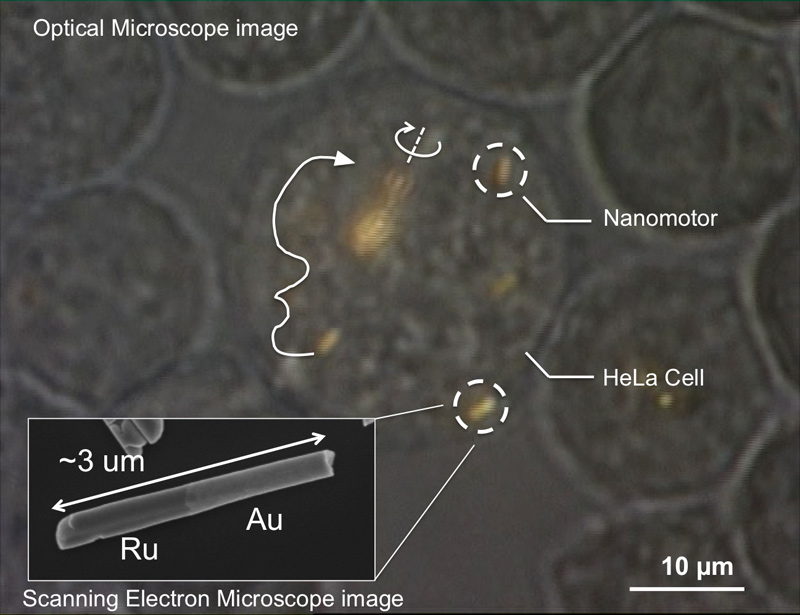
11th February 2014 Nanomotors controlled inside living cells for the first time For the first time anywhere, a team of researchers at Penn State University has placed tiny synthetic motors directly inside live human cells, propelled them with ultrasonic waves and steered them magnetically.
"As these nanomotors move around and bump into structures inside the cells, the live cells show internal mechanical responses that no one has seen before," said Tom Mallouk, Professor of Materials Chemistry and Physics. "This research is a vivid demonstration that it may be possible to use synthetic nanomotors to study cell biology in new ways. We might be able to use nanomotors to treat cancer and other diseases, by mechanically manipulating cells from the inside. Nanomotors could perform intracellular surgery and deliver drugs noninvasively to living tissues." Until now, Mallouk said, nanomotors have been studied only "in vitro" in a laboratory apparatus – not in living human cells. Chemically powered nanomotors were first developed 10 years ago at Penn State by a team that included chemist Ayusman Sen and physicist Vincent Crespi, in addition to Mallouk. "Our first-generation motors required toxic fuels and they would not move in biological fluid, so we couldn't study them in human cells," Mallouk said. "That limitation was a serious problem." When Mallouk and physicist Mauricio Hoyos discovered that nanomotors could be powered by ultrasonic waves, the door was open to studying the motors in living systems. For their experiments, the team used HeLa cells, an immortal line of human cervical cancer cells that is typically used in research studies. These cells ingest the nanomotors, which then move about inside, powered by ultrasonic waves. At low ultrasonic power, the nanomotors have little effect on the cells. But when the power is turned up, the nanomotors spring into action, bumping into organelles – structures within a cell that perform specific functions. The nanomotors can act as egg beaters to homogenise the cell's contents, or they can act as battering rams to puncture the cell membrane.
While ultrasound pulses control whether the nanomotors spin around or whether they move forward, the researchers can control them even further by steering them, using magnetic forces. Mallouk and his colleagues also found that the nanomotors can move autonomously – independently of one another – an ability that is important for future applications. "Autonomous motion might help nanomotors selectively destroy the cells that engulf them," Mallouk said. "If you want these motors to seek out and destroy cancer cells, for example, it's better to have them move independently. You don't want a whole mass of them going in one direction." "One dream application of ours is Fantastic Voyage-style medicine, where nanomotors cruise around inside the body, communicating with each other and performing various kinds of diagnoses and therapy. There are lots of applications for controlling particles on this small scale, and understanding how it works is what's driving us."
Comments »
|







